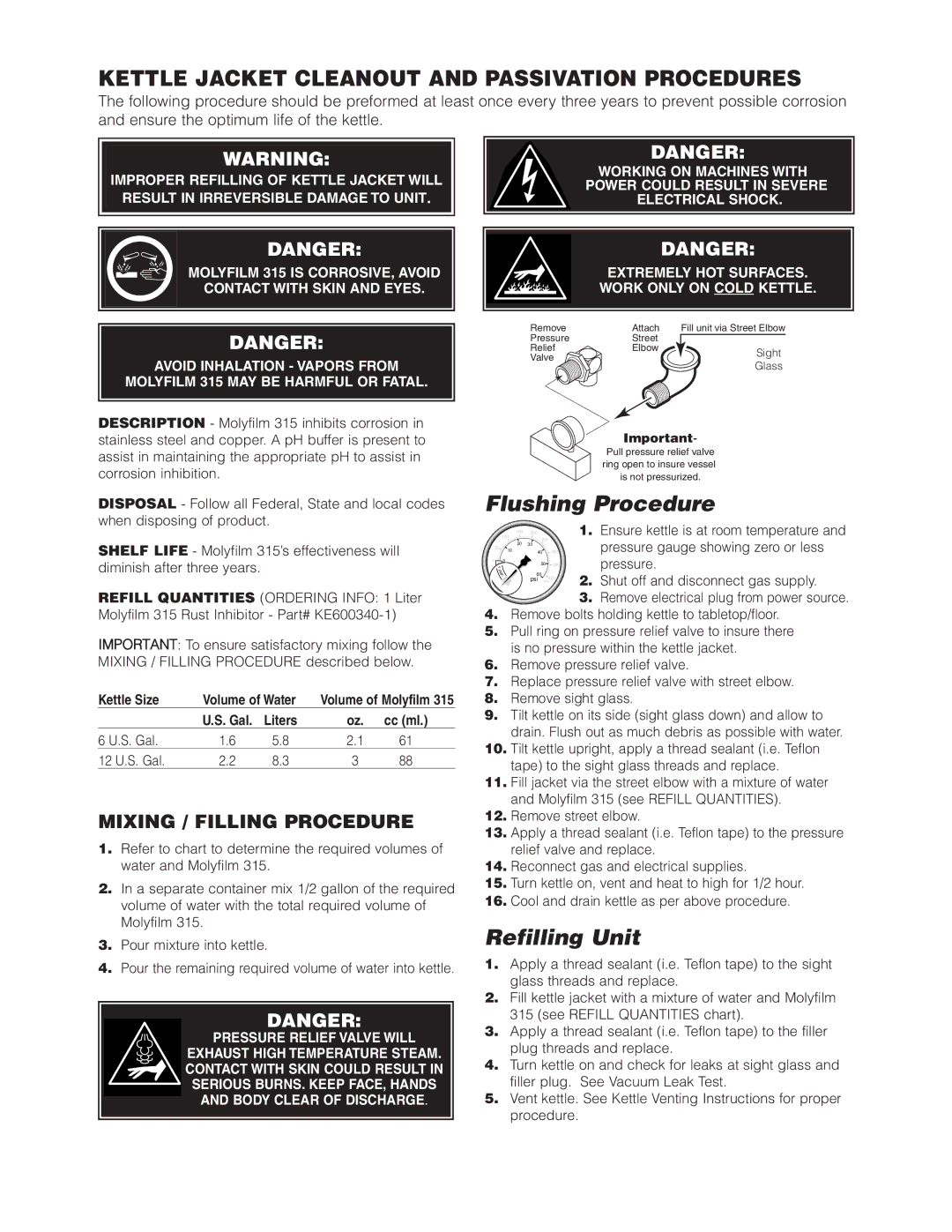
KETTLE JACKET CLEANOUT AND PASSIVATION PROCEDURES
The following procedure should be preformed at least once every three years to prevent possible corrosion and ensure the optimum life of the kettle.
WARNING:
IMPROPER REFILLING OF KETTLE JACKET WILL RESULT IN IRREVERSIBLE DAMAGE TO UNIT.
DANGER:
WORKING ON MACHINES WITH POWER COULD RESULT IN SEVERE ELECTRICAL SHOCK.
DANGER:
MOLYFILM 315 IS CORROSIVE, AVOID
CONTACT WITH SKIN AND EYES.
DANGER:
AVOID INHALATION - VAPORS FROM
MOLYFILM 315 MAY BE HARMFUL OR FATAL.
DESCRIPTION - Molyfilm 315 inhibits corrosion in stainless steel and copper. A pH buffer is present to assist in maintaining the appropriate pH to assist in corrosion inhibition.
DISPOSAL - Follow all Federal, State and local codes when disposing of product.
SHELF LIFE - Molyfilm 315’s effectiveness will diminish after three years.
REFILL QUANTITIES (ORDERING INFO: 1 Liter Molyfilm 315 Rust Inhibitor - Part#
IMPORTANT: To ensure satisfactory mixing follow the MIXING / FILLING PROCEDURE described below.
Kettle Size | Volume of Water | Volume of Molyfilm 315 | ||
| U.S. Gal. | Liters | oz. | cc (ml.) |
6 U.S. Gal. | 1.6 | 5.8 | 2.1 | 61 |
12 U.S. Gal. | 2.2 | 8.3 | 3 | 88 |
MIXING / FILLING PROCEDURE
1.Refer to chart to determine the required volumes of water and Molyfilm 315.
2.In a separate container mix 1/2 gallon of the required volume of water with the total required volume of Molyfilm 315.
3.Pour mixture into kettle.
4.Pour the remaining required volume of water into kettle.
DANGER:
PRESSURE RELIEF VALVE WILL
EXHAUST HIGH TEMPERATURE STEAM.
CONTACT WITH SKIN COULD RESULT IN
SERIOUS BURNS. KEEP FACE, HANDS
AND BODY CLEAR OF DISCHARGE.
|
| DANGER: |
| EXTREMELY HOT SURFACES. | |
| WORK ONLY ON COLD KETTLE. | |
Remove | Attach Fill unit via Street Elbow | |
Pressure | Street |
|
Relief | Elbow | Sight |
Valve |
| |
|
| |
Glass
|
|
|
|
|
|
| Important- |
|
|
|
|
|
|
| Pull pressure relief valve |
|
|
|
|
|
|
| ring open to insure vessel |
|
|
|
|
|
|
| is not pressurized. |
Flushing Procedure | |||||||
|
| 150 | 200 |
|
| 1. | Ensure kettle is at room temperature and |
| 100 | 250 |
| ||||
|
| 20 |
|
| pressure gauge showing zero or less | ||
50 | 30 |
|
|
| |||
10 | 40 |
| 300 |
| |||
|
|
|
| ||||
0 | 0 |
| 50 |
|
| pressure. | |
| R |
| 350 |
| |||
| I |
|
| ||||
| A |
|
|
|
| ||
| T |
|
|
|
|
| |
| N |
|
|
|
|
| |
| E |
| 60 |
|
| 2. Shut off and disconnect gas supply. | |
| V |
|
| 400 | |||
|
|
| psi |
| |||
|
|
| kPa | ||||
|
|
|
|
|
| ||
3.Remove electrical plug from power source.
4.Remove bolts holding kettle to tabletop/floor.
5.Pull ring on pressure relief valve to insure there is no pressure within the kettle jacket.
6.Remove pressure relief valve.
7.Replace pressure relief valve with street elbow.
8.Remove sight glass.
9.Tilt kettle on its side (sight glass down) and allow to drain. Flush out as much debris as possible with water.
10.Tilt kettle upright, apply a thread sealant (i.e. Teflon tape) to the sight glass threads and replace.
11.Fill jacket via the street elbow with a mixture of water and Molyfilm 315 (see REFILL QUANTITIES).
12.Remove street elbow.
13.Apply a thread sealant (i.e. Teflon tape) to the pressure relief valve and replace.
14.Reconnect gas and electrical supplies.
15.Turn kettle on, vent and heat to high for 1/2 hour.
16.Cool and drain kettle as per above procedure.
Refilling Unit
1.Apply a thread sealant (i.e. Teflon tape) to the sight glass threads and replace.
2.Fill kettle jacket with a mixture of water and Molyfilm 315 (see REFILL QUANTITIES chart).
3.Apply a thread sealant (i.e. Teflon tape) to the filler plug threads and replace.
4.Turn kettle on and check for leaks at sight glass and filler plug. See Vacuum Leak Test.
5.Vent kettle. See Kettle Venting Instructions for proper
procedure.
